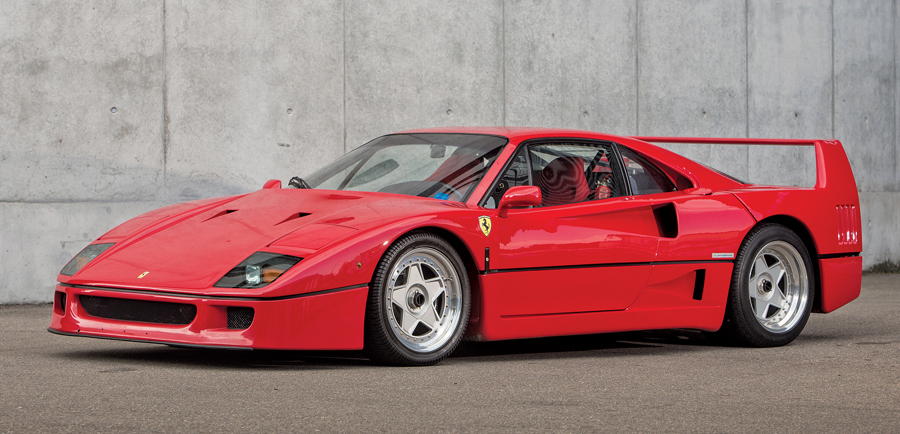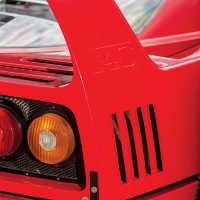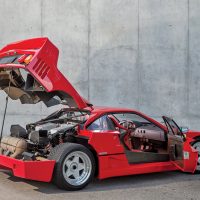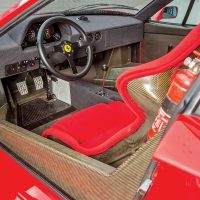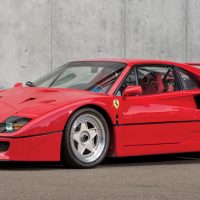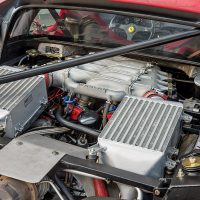- Desirable “non-cat” and “non-adjustable” model
- Three private owners and fewer than 20,000 kilometers (12,400 miles) from new
- Single private ownership for over 25 years
- Air conditioning, wind-up windows, Sabelt harnesses
- Ferrari Classiche certified
SCM Analysis
Detailing
| Vehicle: | 1989 Ferrari F40 Berlinetta |
| Years Produced: | 1988–92 |
| Number Produced: | 1,311 |
| Original List Price: | $399,100 |
| SCM Valuation: | $1,301,500 |
| Tune Up Cost: | $4,000 |
| Chassis Number Location: | Stamped on the frame in front compartment under washer bottle |
| Engine Number Location: | On top of the engine by the water pump |
| Club Info: | Ferrari Club of America |
| Website: | http://www.FerrariClubofAmerica.org |
| Alternatives: | 1991–93 Jaguar XJ 220, 1986–88 Porsche 959, 2004–09 Mercedes-Benz SLR McLaren |
| Investment Grade: | A |
This car, Lot 35, sold for $1,015,956, including buyer’s premium, at Bonhams’ Zoute, Belgium, sale on October 11, 2019.
I was called to task for something I wrote in last month’s SCM Daytona Profile (December 2019, p. 70). A reader took issue with my implication that Daytonas aren’t more valuable because too many were built. He pointed out there were far more Mercedes-Benz 300SL Gullwings (1,400) and 300SL Roadsters (1,856) and Ferrari F40s (1,311) than Daytona coupes (1,279).
He noted the SLs and F40s sold for two or more times more than a Daytona. His point was that quantity alone doesn’t equate to value, and he was right.
The late John Apen, who wrote for SCM and happened to be my mentor, taught me this: All valuable things are rare, but not all rare things are valuable.
I’ve had to remind myself of that many times through the years, like when I came across an original roof for a 275 GTB. Surely a roof for one of the most valuable cars on the planet must be valuable, but no. As fewer 275 GTBs are driven, there is almost no chance of one ever ending up on its roof again. If one did go reverse turtle, a new roof would not be hard to fabricate and would be indistinguishable from an original. The roof had little value.
We’ve all been intrigued by a car that was the only one made in a particular color. Usually there was only one built in that color because only one person wanted one.
We once found a Ferrari Dino that was a rare color under the red paint it was sporting. It needed fresh paint, so we decided to change it back to its original color. Everyone who saw the car would comment on the unusual paint before asking for us to call them when we got a red one.
The color was rare, but it wasn’t valuable.
Not rare — but very valuable
F40s aren’t particularly rare, but they are definitely valuable. There simply is more demand than supply.
Daytonas are cool, but the newest one is 46 years old. Car collectors buy what they lusted for when they were young. The prime candidate for a Daytona is around 70 years old now. A 70-year-old’s interest in cars may still be keen, but their buying activity is diminished.
In contrast, the ideal candidate for an F40 would be almost 20 years younger. Many of the potential buyers are in the full stride of their careers — and with substantial resources. If they want an F40, price is not a barrier.
Every few years, SCM does an updated F40 profile. The last one was in 2017 (October 2017, p 86). At that time, I wrote, “Today U.S. prices yo-yo between $1,100,000 and $1,500,000, depending on the condition of the car.” That isn’t much different from what I would have written in 2015.
The 2019 update is more of the same. The bottom end is down to around $1 million today, but the upper end hasn’t really changed.
Condition is key to F40 value
The decline at the bottom end can be attributed to a decline in car quality rather than a softer market.
F40s run the spectrum from ultra-low-mileage collector examples to well-used drivers. Both ends of the spectrum are feeling the effects of aging.
The earliest cars are now 30 years old. The red seat fabric started deteriorating years ago. Plastic rear windows are getting micro-cracks. Books and tools have been lost, and fresh paint covers small and large incidents. Million-dollar buyers want the best car, and those with needs have seen a value decline.
Maintenance is also a factor in valuation. Engine-out belt services need to be done whether the car is driven or not. “While we’re here” work can double or triple the cost of a major service.
High-performance tires should be replaced every five years. Euro models have two $12,000 fuel bladders that require periodic replacement. A low-mileage car that hasn’t turned a mile in years can easily require $25,000 or more to put it back on the road again.
These cars should be driven
The low-mileage cars that bring the big money generally stay locked in the garage, and that’s a shame. The F40 is the ultimate driver’s Ferrari, and not using one is missing one of the most exciting experiences in the performance-car world.
Many new cars are faster than a F40, but none are as rewarding to drive. The F40 is raw; there are no driver’s aids, no power steering, and no F1 transmission.
You sit in a racing-style bucket seat in a basic interior that’s devoid of carpeting, sound-deadening material or a radio. Air conditioning is the only nod to driver comfort.
Turn the key, press the start button and the F40 springs to life. The engine will sound healthy, but with less snarl than more-modern cars.
The car is perfectly docile at light-to-mid throttle, but when you get into the boost, Dr. Jekyll turns into Mr. Hyde. In first and second gears, on the boost, tire spin is a given. In third gear the tires can break loose in irregular pavement. Pushing an F40 is an unparalleled thrill that has seduced owners to regularly drive a car they intended to be a garage queen.
A sweet example
Our subject F40 hit my personal sweet spot. The reported 20,000 kilometers is around 12,400 miles. The mileage is high enough that the buyer isn’t paying a premium for a low-mileage car, but it is high enough that adding another 6,000 or so kilometers won’t kill the value.
It is a European model delivered without catalytic converters and with non-adjustable suspension. The 2014 major service needs updating, but the fuel tanks were replaced in 2017, removing that worry for many years.
The slightly over $1 million sale was at the low end of the range — but on the money for a European sale, where F40s sell for less than in the United States. No one got hurt, and no one won the lottery on this one.
The new owners can drive the tires off it without losing much money, and I hope they do. ♦
(Introductory description courtesy of Bonhams.)
